Acid rain is a problem in Scandinavia. Electricity-generating plants burn coal and emit sulfur dioxide. That sulfur
Question:
Acid rain is a problem in Scandinavia. Electricity-generating plants burn coal and emit sulfur dioxide. That sulfur dioxide is converted to sulfates, which travel long distances and are washed out of the air as acidic rain, particularly affecting Swedish lakes. Assume that power plants in England and Denmark are the primary culprits. Also assume that in a year one tonne of sulfur emitted in England generates deposition in Sweden of 1 gram of sulfate deposition and one tonne of sulfur from Denmark generates 3 grams of deposition in Sweden. Damage from acid rain is approximately 1 pence per gram of sulfates deposited. If \(q\) is the reduction in annual sulfur emissions (in tonnes) from uncontrolled levels, the marginal cost of controlling sulfur emissions is \(£ q\) for Denmark and \(£ 2 q\) for England [ \(1 £=100\) p].
a. Write the damage function, giving damages as a function of total sulfates deposited.
b. Write the transfer coefficients for England and Denmark.
c. What is the efficient amount of emissions from England and Denmark and the resulting pollution in Sweden? What are the resulting control costs for the two polluting countries and the damage in Sweden?
d. First ignore the effects of pollution on Sweden and suppose we want simply to reduce emissions by 12 tonnes. How much of that reduction should come from Denmark, on the basis of cost efficiency?
e. Now suppose we want to reduce emissions by 12 tonnes but we want to do it in a way that takes into account effects on pollution in Sweden. Although this might not be the right amount of pollution reduction, balancing the marginal cost of controlling pollution in Sweden from the two source countries would require how much of an emission reduction in Denmark?
Step by Step Answer:






